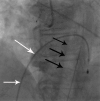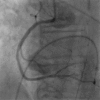Cardiogenic Shock with Complete Atrio-ventricular Block in an Octogenarian Woman: Are we going too far?
- PMID: 25170415
- PMCID: PMC4137576
- DOI: 10.5001/omj.2014.78
Cardiogenic Shock with Complete Atrio-ventricular Block in an Octogenarian Woman: Are we going too far?
Abstract
We report a case of an octogenarian woman who suffered from cardiogenic shock following an inferolateral myocardial infarction extending to the right ventricle associated with complete atrioventricular heart block. Her initial status was critical with a poor prognosis. She requested an invasive full management to be able to continue to take care of her ill husband. She was managed with circulatory assistance, temporary pacing and percutaneous coronary intervention. The procedure was successfully performed and the patient showed a remarkable improvement in clinical condition. Cardiogenic shock complicating right heart ventricle in elderly requires careful patient selection for invasive strategies that can sometimes rely on the willingness of the patient, as the procedural outcome appears to be poor in this high-risk population.
Keywords: Cardiogenic shock; Octogenarian; Percutaneous coronary intervention.
Figures



References
-
- Leprince P, Bonnet N, Varnous S, Rama A, Ouattara A, Makri R, et al. [Post-myocardial infarction cardiogenic shock and circulatory assistance]. Arch Mal Coeur Vaiss 2005. Nov;98(11):1090-1094 - PubMed
-
- Marcolino MS, Simsek C, de Boer SP, van Domburg RT, van Geuns RJ, de Jaegere P, et al. Short- and long-term major adverse cardiac events in patients undergoing percutaneous coronary intervention with stenting for acute myocardial infarction complicated by cardiogenic shock. Cardiology 2012;121(1):47-55 10.1159/000336154 - DOI - PubMed
-
- Goldberg RJ, Spencer FA, Gore JM, Lessard D, Yarzebski J. Thirty-year trends (1975 to 2005) in the magnitude of, management of, and hospital death rates associated with cardiogenic shock in patients with acute myocardial infarction: a population-based perspective. Circulation 2009. Mar;119(9):1211-1219 Published online 23 Feb 2009. 10.1161/CIRCULATIONAHA.108.814947 - DOI - PMC - PubMed
-
- Centers for Disease Control and Prevention (CDC) Trends in aging–United States and worldwide. MMWR Morb Mortal Wkly Rep 2003. Feb;52(6):101-104, 106 - PubMed
-
- Sukiennik A, Król A, Jachalska A, Koziński M, Fabiszak T, Kubica A, et al. Percutaneous coronary angioplasty in elderly patients: Assessment of in-hospital outcomes. Cardiol J 2007;14(2):143-154 - PubMed
Publication types
LinkOut - more resources
Full Text Sources
Other Literature Sources
